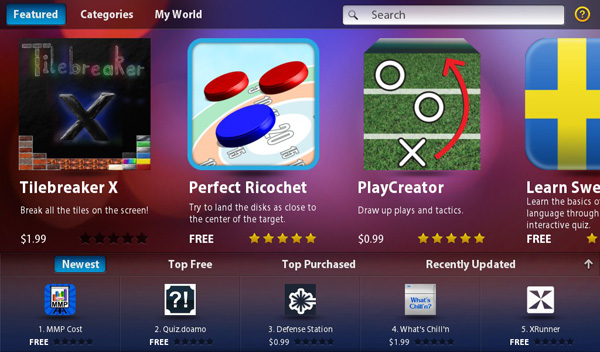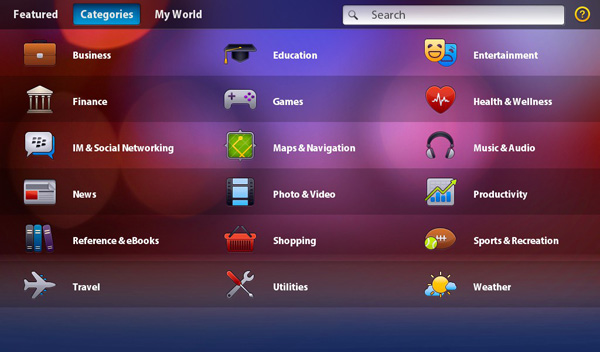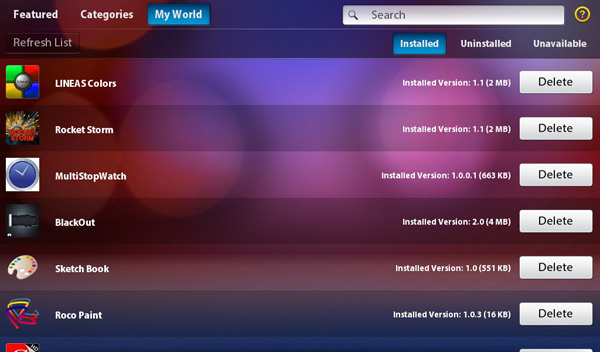The BlackBerry PlayBook Review
by Anand Lal Shimpi on April 13, 2011 9:00 PM EST- Posted in
- Tablets
- Smartphones
- RIM
- BlackBerry
- PlayBook
- Mobile
Apps and Development
Everyone loves to repeat Apple's iOS app number verbatim: "65,000 iPad apps and counting" was the talking point after the iPad 2 launch event. In reality, that's hundreds of times more than the number of apps you'll actually use on a regular basis. Most of the really popular apps are cross platform, at least when it comes to iOS and Android. There are definitely iOS exclusives just as there are Android exclusives, perhaps more of the former than the latter but ultimately I don't put too much weight on quantity of apps. If there's something in particular you want that doesn't exist for one platform but does for another, that's worth talking about.
The PlayBook app experience, at least on day one, unfortunately isn't anywhere near that of what you get on Honeycomb. So if you felt that Honeycomb was under-supported by 3rd party apps at launch, the PlayBook will disappoint you.
Let's first talk about App World - RIM's app catalog on the PlayBook. Apps are divided into categories and you can of course look at the top free, top purchased, newest and recently updated apps. I haven't encountered an app that needs updating so I'm not entirely sure how that process works yet.
Browsing for apps by category is a bit more complicated than I'd like. Each category seen in the screen below has a handful of subcategories:
I've noticed that app categorization doesn't always match up with the sub categories properly. There is of course full text search in App World, which seems to work well except that there just isn't that much to search for today.
One nice feature of the App World app is the My World page. Here you get a list of everything you've installed on the app (including size and version number) and you're given the option of deleting apps from here.
RIM also provides you with a list of apps you've deleted and gives you the option of reinstalling any of them. So if you deleted something you end up missing, you don't have to go searching for it again - it's just in the uninstalled tab in My World. Deleted/uninstalled apps don't physically reside on your device so they'll have to be re-downloaded, but the convenience is still nice.
You don't need to login with your BlackBerry ID to download free apps, but anything you have to purchase requires an authentication step.
App World is one of the few first party apps that just isn't very smooth. Animations are choppy and the whole thing just begs to be optimized. I can't stress enough how having a mixture of 60 fps and sub-30 fps frame rates on the same tablet somehow stands out more than if the device were just consistently below 30 fps.
RIM sent along a list of companies that are working on PlayBook apps, however I don't have specifics as to what they're working on or when it'll be released:
· Adobe Connect & Lifecycle
· Airplay
· Atari
· BoxTone
· Cerner Corporation
· Digital Chocolate
· EA
· eBay
· EpixHD
· Evernote
· FGL
· Fortune
· Gameloft
· Globe & Mail
· HFMUS - Car and Driver magazine
· Huffington Post
· Loblaws
· Mattel
· MediaFly
· OpenText Everywhere
· Post Media
· Salesforce.com - Chatter
· ScoreMedia (ScoreMobile)
· Slacker Radio
· Sports Illustrated
· Telicost (Anomalous Networks)
· The Weather Channel
· The Weather Network
· Time
· Unity3D
In terms of developing apps for the PlayBook you really have three options: the WebWorks SDK, BlackBerry Tablet OS SDK for Adobe AIR and native C/C++.
The WebWorks SDK enables HTML5 and JavaScript based apps to run on the PlayBook, similar to what the original apps for iOS were like. The Tablet OS SDK for Adobe AIR lets you bundle and target the PlayBook with apps you've built using Adobe Flash Builder. And finally, the highest performance option is to obviously write native C/C++ targeting the PlayBook.
There is a fourth method of getting apps onto the BlackBerry PlayBook, using an as-of-now unreleased Android App Player. RIM is working on a port of Android that will run on top of QNX, abstracted from the underlying hardware/software (think VM). The Android App Player should be able to run all apps that work on Gingerbread (Android 2.3). You won't get access to the Android marketplace, developers will still have to package and send all apps to RIM for signing - but it should allow existing Android developers to avoid a full blown code re-write in order to get their apps working on PlayBook right away.
It's still far too early to see how successful this is going to be and I do have concerns about performance (the layer between QNX and Android is bound to cause a performance impact). Of course Android apps won't have direct access to hardware so things like 3D games are likely going to be too slow to work at all. It's an interesting option but I'll reserve judgement until I see it implemented in a shipping device. At this point I wouldn't assume that the PlayBook is just going to give you a great Android app experience as well as a great PlayBook experience. I think that's simply too far fetched.














77 Comments
View All Comments
tipoo - Wednesday, April 13, 2011 - link
Did you have anything running in the background there? Gizmodo and Engadget both got within 10% of the iPad 2's score, the one here seems to be much slower.Anyways, as usual this is easily one of the best reviews.
Anand Lal Shimpi - Wednesday, April 13, 2011 - link
This may be a sunspider 0.9 vs. 0.91 issue, RIM said the same thing but 0.9 for some reason gives us the scores you see on the PlayBook vs. the competition (just re-ran again to be sure).I'm still waiting for a response from RIM as to why the relative performance comparison is much worse under 0.9. We've stuck with 0.9 to maintain backwards compatibility with our older smartphone numbers but if need be I'll switch over to 0.91 for tablets.
I'm running 0.91 numbers now, let's see what I come up with.
Thanks for reading and your kind words :)
Take care,
Anand
Anand Lal Shimpi - Thursday, April 14, 2011 - link
This is definitely a 0.9.1 vs. 0.9.0 issue. I'm not sure what is causing the PlayBook to choke on 0.9.0. I will update the article with 0.9.1 numbers as well.Take care,
Anand
8steve8 - Wednesday, April 13, 2011 - link
very high black levels on the screen is disappointing. (samoled/samoled+ is amazing)Also the bezel looks like its a huge percentage of the surface area, which is ugly.
7" seems to be the worst size, too big for pockets, too small for ideal consumption of entertainment or web.
The Base OS seems decent, although without email or calendar, we will have to give this another look in august.
That said, I still find tablets a niche device that few situations actually call for. Usually I find myself wanting a physical keyboard, or at least more screen space while typing. Also if you have to constantly hold it up, or buy a stand, why not use little laptops laptops, the screens don't need a stand : )
I find it a good device for a coffee table or any profession where you are standing/not at a table. Otherwise I'll stick to smartphone/laptop or desktop.
Solandri - Thursday, April 14, 2011 - link
The contrast ratio is the same as the iPad 2, so the high black levels is an artifact of the high white levels. In other words, if you turned down the brightness to match the max brightness of the iPad 2, the black levels should be the same as on the iPad 2.Along the same lines, I'm wondering what was the brightness setting during the battery tests. Usually reviewers do something like set brightness to half during the battery tests. But that seems a bit unfair since the Playbook's screen is so much brighter than the competition's. Wouldn't a more fair comparison be to set its brightness output to be the same number of nits as the iPad 2 in its battery test? In effect, think of the screen as the same as the iPad 2, but with the option to really crank up the brightness if you're outdoors in sunlight.
Anand Lal Shimpi - Thursday, April 14, 2011 - link
So our old method was to set everything to 50%, but lately I've been doing brightness matching right around ~150 nits on these tablets.Take care,
Anand
HilbertSpace - Wednesday, April 13, 2011 - link
Conclusion page:"I'm glad to see RIM experimenting with form factors. After using the Galaxy Tab 8.9 at CTIA I felt that may be the perfect balance between portability and functionality. The 7-inch PlayBook "
- something got mixed up there.
Aikouka - Wednesday, April 13, 2011 - link
I wonder if the browser would be better if you had the option to hide the menu/address bar?Anand Lal Shimpi - Thursday, April 14, 2011 - link
You actually do have the option to hide the menu/address bar, it's in the upper right corner of the browser. That does improve things but it also makes it less convenient to navigate to the next website.Take care,
Anand
jjj - Wednesday, April 13, 2011 - link
In the final words it would be worth reminding readers that it has no SD card slot, IMO a fundamental feature for phones/tablets nowdays.